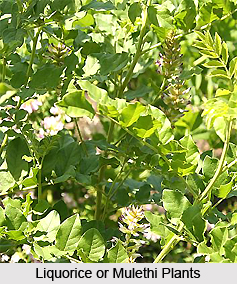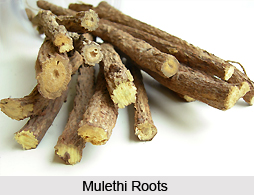 Liquorice has been known to pharmacists for thousands of years. In ancient Chinese pharmacy, it was used for its regenerating properties, principally when used for long periods. It was used to satisfy thirst, assuage feverishness, pain, cough and agony in breathing.
Liquorice has been known to pharmacists for thousands of years. In ancient Chinese pharmacy, it was used for its regenerating properties, principally when used for long periods. It was used to satisfy thirst, assuage feverishness, pain, cough and agony in breathing.
Liquorice plays a substantial role in Ayurvedic system of medicine and is one of the principal drugs mentioned by Susruta.
Methods of usage
Liquorice has the power to mend the customary everyday ailments, including abdominal problems, aching throat, cough, constipation, blisters and even myopia.
Healing Power and Medicinal Properties of liquorice
The root of the plant acts as a purgative and expectorant. When applied externally, it produces a cooling effect on the skin. Fine-grained liquorice is very well accepted in allopathic medicine.
Stomach Disorders cured by liquorice
Liquorice is an exceptional antidote for assuaging pain, uncomfortable ness and other symptoms caused by unpleasant matter in the stomach. It should be taken in grinded form.
Sore Throat healed by liquorice
The herb is an acknowledged household remedy for aching throat. A minute piece of raw liquorice if chewed or sucked, provides alleviation by relaxing the swelling.
Cough cured by liquorice
Lubing the throat with a decoction of liquorice coalesced with honey brings respite to dry cough.
Myopia healed by liquorice
Liquorice is used in the cure of myopia. Half a teaspoon of the pulverisation of the root, blended with an equal quantity of honey and half the quantity of ghee, can be had twice a day, with milk in empty stomach.
Constipation healed by liquorice
Liquorice is also used as a purgative in constipation. Its pulverisation is consumed with jaggery and water in such conditions.
 Stomach Ulcer cured by liquorice
Stomach Ulcer cured by liquorice
Liquorice is very efficacious in treating soreness due to stomach ulcers, as it cools down the discomfort caused by acids. Pieces of the dried root imbued overnight in water and the concoction taken with rice helps in the therapy of ulcers. Even allopathic physicians use liquorice for curing ulcers.
Muscular Pains cured by liquorice
Liquorice assuages muscular aches. Taking a concoction of the roots imbued overnight alleviates any acute joint ailments.
Mouth Disorders healed by liquorice
The sticks of dried rhizomes are dowsed in water and the concoction used as a gargle brings fast reprieve in oral swellings. Tiny bits of the stick with sugar-candy can also be imbibed. The herb is efficacious in treating irregular baldness. Small amounts of the root are mashed in milk with a hint of saffron to a paste. When this paste is administered over the bald patches at bedtime everyday, hair outgrowth is seen within just a few weeks. This prescription is very effectual in the preliminary phases of baldness, unwarranted hair loss and dandruff.
Wounds and Scalds healed by liquorice
Liquorice powder combined with butter or ghee and honey, can be massaged on cuts and injuries with honest results. The leaves of the plant, implemented as a poultice, are a functional remedy in scalds of the head and body.
Corns cured by liquorice
The herb heals corns that have just begun to appear. A paste of liquorice sticks, blended with sesame or mustard oil if rubbed into the tough skin at bed time, dampens the skin and the corn diminishes in size.
Precautions - Unremitting and incessant use of liquorice in the treatment of stomach ulcer is not wise, because it can cause weight gain and bulging of body. It should also be averted during pregnancy and in cardiac and renal conditions.
Composition
Liquorice is an admired seasoning agent. It is a soaring, upright herb, growing upto nearly 1.5 metres in height. It has compound leaves, lilac or light violet flowers, flat fruit and is thickly covered with tiny spinous offshoots. The dried roots and underground stems or rhizomes of the plant make up the drug.
Liquorice is domesticated in southern Europe, Syria, Iraq, Turkey, Greece and Russia. Vast quantities of these roots are imported in India once a year, though it is also cultivated in north-western parts of the country.
The herb contains glycyrrhizin, glycyrrhizic acid and gtycyrrhetinic acid.











